Wilfrid Kingsford-Smith
12th of March, 1882 - january 13, 1960
Australia has had many private individuals develop infrastructure and establish whole new industries based upon need that have then gone on to serve other Australians and the rest of the world. Surf Life saving would be a prime example. The world of aviation is another. Wilfrid Kingsford Smith established regional flying and mail runs (here and NZ)
Wilfred also ensured Australia had her own trained ground engineers and pilots in pre-war and in post war (WWII) as the principal of the College of Civil Aviation, instigated R.A.A.F. personnel learning air navigation and was the first instance of civilians being taught all about radar in the world. He was progressive, inventive, passionate about flying, an entrepreneur and a bit of a hidden story despite his massive contributions to Australian aviation.
Wilfred Kingsford Smith was born in Brisbane, Queensland, Australia on March 12, 1882.
Elder brother by 14 years of Charles Kingsford Smith and one of seven children of Catherine Mary Kingsford and William Charles Smith, Bank Manager, Wilfrid (spelt Wilfred in some sources) Smith spent his boyhood growing up in Cairns. Their mother changed their name at this time to Kingsford Smith reputedly after a man living in the same street, also by the surname of Smith, kept receiving their mail and not returning it.
In 1896 the family moved from Cairns to Hamilton in QLD, where brother Charles was born and then, in 1905, to Vancouver in Canada where their father worked with Canadian Pacific Railways. They returned to Sydney. Here Wilfrid, now 23, met and married Ernestine Lovell (nee Slatter, born St Leonards, 1887), in 1910 at Hunters Hill. They had three sons: John Wilfrid, Peter and Rollo, and one daughter, Margaret.
KINGSFORD-SMITH (nee Ernestine Slatter) - May 7th at their residence The Gunyah, Toowoomba Queensland to Mr and Mrs Wilfrid Kingsford-Smith – a son. Family Notices. (1911, May 13). The Sydney Morning Herald (NSW : 1842 - 1954), p. 12. Retrieved from http://nla.gov.au/nla.news-article15249689
 (1).jpg?timestamp=1668820655737)
Arrival of Charles Kingsford Smith in "Southern Cross" at Eagle Farm Aerodrome, Brisbane, Australia, after first crossing of the Pacific Ocean from San Francisco, 9 June 1928. Photo: Queensland State Archives
Australian National Airways was founded by Charles Ulm and Charles Kingsford Smith in 1929 and began operations in January 1930. They flew Avro 618 Tens, similar aircraft to Kingsford Smith's famous Southern Cross. However, the airline folded in 1931 after the crash of VH-UMF Southern Cloud in the Australian Alps between Sydney and Melbourne, and VH-UNA Southern Sun in Malaya. Tom Perry, a Narromine grazier and philanthropist who was the enthusiastic president of the local aero club provided financial backing to a new venture, which Wilfrid Kingsford Smith was due to start a few months later. From 1932 Wilfred travelled from Adelaide to Goulburn establishing regional air travel and airmail as W.A.S.P (Western and Southern Provincial) Air Lines. Despite this being the Depression era, this new business seemed to flourish. In 1933 the brothers were planning on extending air travel and airmail to New Zealand:
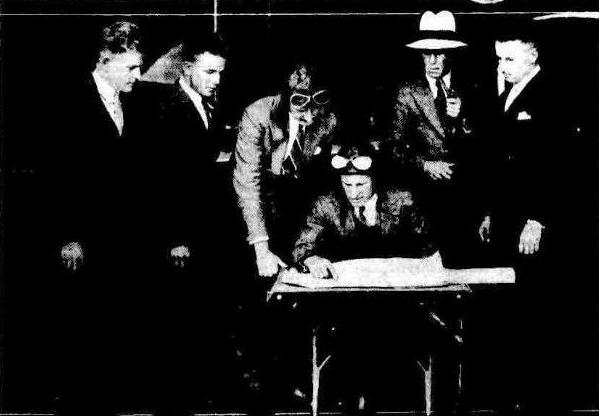
PREPARING FOR TASMAN FLIGHT- The Southern Cross, when it leaves on the flight from New South Wales to New Zealand, will carry the following:-Mr. H. Affleck (aircraftsman), Mr. t. Pethrybridge (chief engineer), Mr. P. G. Taylor (second pilot), Sir Charles Kingsford Smith (leader), Mr. Wilfrid Kingsford Smith (manager), and Mr. J. W. T. Stannage (wireless operator). No title. (1933, January 10). The Argus (Melbourne, Vic. : 1848 - 1956), p. 5. Retrieved from http://nla.gov.au/nla.news-article4518589
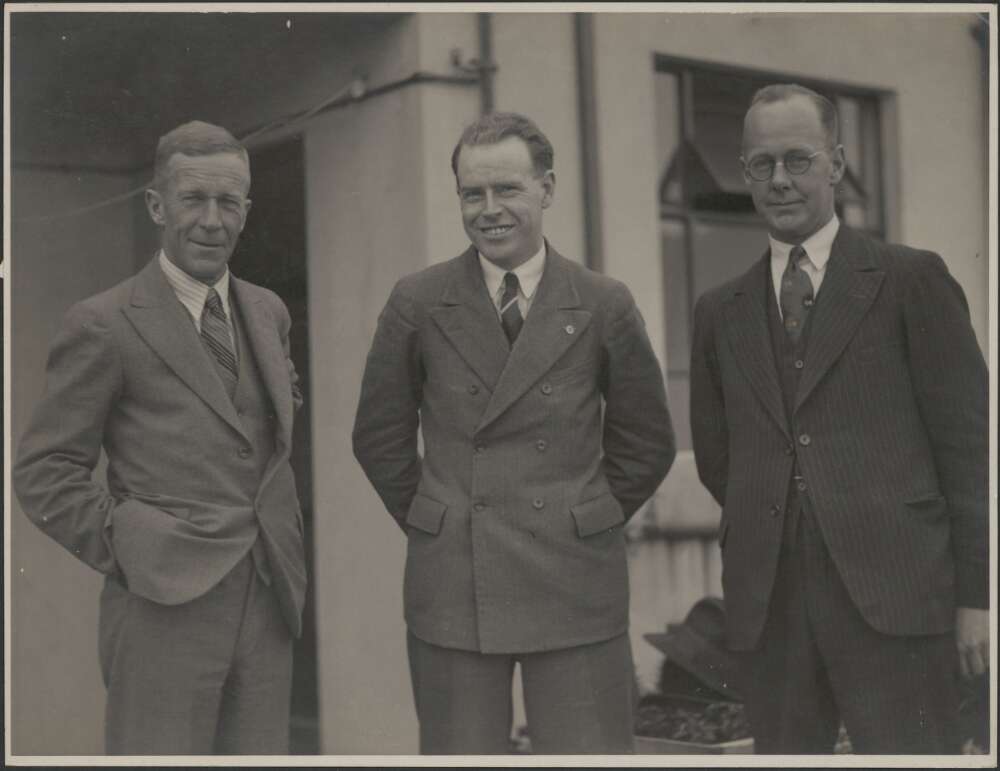
Portrait of Wilfred Kingsford-Smith, B. Sheil, Mr S.E. Neilsen in New Zealand, 1930s nla.pic-vn3722921, courtesy National Library of Australia
LEETON, Tuesday. Speaking at the Inauguration of the regular passenger air service between Leeton and Sydney, Wilfred Kingsford Smith said the daily service would soon be in operation. His company had planned that in five years time the residents of Leeton should be 'enabled to leave at 6 p.m., visit a theatre in Sydney, and be home at Leeton at l a.m. next day. THEATRES BROUGHT TO COUNTRY REACH. (1935, August 21). The Canberra Times (ACT : 1926 - 1954), p. 3. Retrieved from http://nla.gov.au/nla.news-article2396933
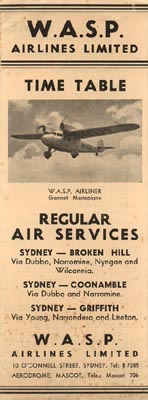 WASP Air Lines, like many other Kingsford Smith ventures in aviation, had problems The service to Leeton was ended in 1936 when a Tugan Gannet aircraft used by W.A.S.P. Airlines crashed on 26 February 1936 in the Cordeaux Dam area but continued elsewhere:
WASP Air Lines, like many other Kingsford Smith ventures in aviation, had problems The service to Leeton was ended in 1936 when a Tugan Gannet aircraft used by W.A.S.P. Airlines crashed on 26 February 1936 in the Cordeaux Dam area but continued elsewhere:
FIRST AIR MAIL. SYDNEY TO BROKEN HILL. Link with Adelaide and Perth.; The first air mail from Sydney to Broken Hill will be carried to-day by the Wasp Air-lines' Gannet 'plane, which will leave Mascot at 8 a.m. Mall for Dubbo, Narromine, Nyngan, and Wilcannia will be dropped off on the way. It is expected that the 'plane will reach Broken Hill at 1.30 p.m. in time to connect with the machine for Adelaide, so that Adelaide mail will reach Its destination to-night. As the Adelaide-Perth air mail leaves Adelaide on Saturday morning, mail for Western Australia will also make a suitable connection and will reach Perth on Sunday. Air mall will be carried to Broken Hill on Tuesdays and Fri-days, and the Friday mall will link up with the Perth service. The managing director of Wasp Airlines, Ltd. (Mr. Wilfred Kingsford Smith) stated yesterday that arrangements had been practically completed to equip all the company's machines with wireless and for the Installation of a radio beacon. FIRST AIR MAIL. (1936, March 27). The Sydney Morning Herald(NSW : 1842 - 1954), p. 10. Retrieved from http://nla.gov.au/nla.news-article17336456
A long standing friendship with P G Taylor, resident of Bayview, may have introduced the Kingsford Smiths to Pittwater.
By 1939 Wilfred Kingsford-Smith had had a home built at Taylors Point, then still pristine bushland. This timber-framed building with a low-pitched skillion roof was designed by the same academic and architect who built Elaine Haxton’s home, Arthur Baldwinson (pictures below).
However, a photo held by the State L:ibrary of NSW shows his brother Charles at Palm Beach during this time, obviously about to go surfing or having just come in:
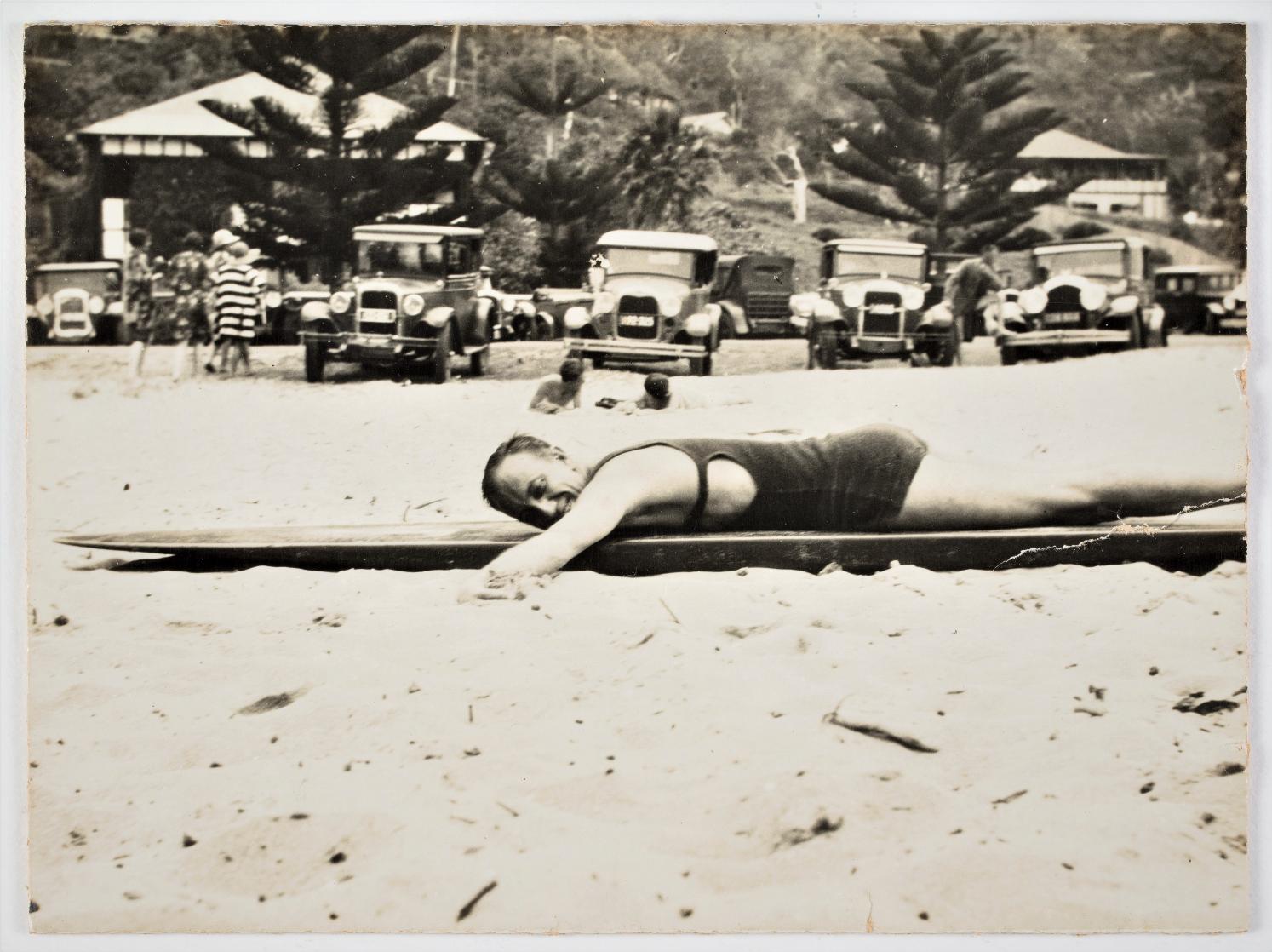
Progress Of Aviation:
It is expected the coming year will see important developments in all phases of aviation, particularly the manufacturing side. In a statement at the week-end, Mr. Wilfrid Kingsford Smith, a brother of the late Sir Charles Kingsford-smith, said the College of Civil Aviation intends to erect a hangar at Mascot, so that practical training can be given to ground engineers, "Aviation training facilities in the past have been mainly directed towards flying," said Mr. Kingsford Smith. "The College of Civil Aviation will be conducted on the same lines as leading British and American aviation engineering schools, and it will give complete practical workshop instruction in aircraft maintenance." The Minister for Civil Aviation (Mr.Thorby) recently granted permission to aero clubs to undertake repair and overhaul work on aircraft other than those already owned and operated by them, because of a marked shortage of ground, engineers. BRIGHT NOTE STRUCK. (1939, January 2). The Mercury (Hobart, Tas. : 1860 - 1954), p. 6. Retrieved from http://nla.gov.au/nla.news-article25577663
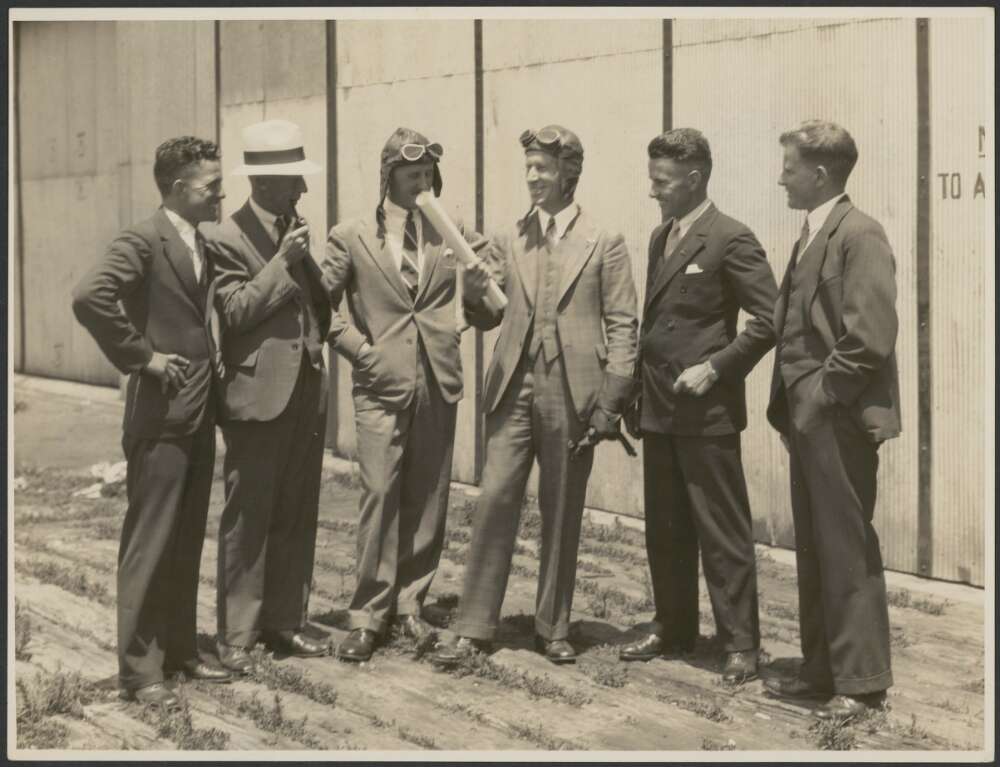
Group portrait of T. Pethybridge, W. Kingsford Smith, P.G. Taylor, C.E. Kingsford Smith, John Stannage, H. Affleck, Mascot Aerodrome, Sydney, 1934 [picture]. nla.pic-vn3930671, courtesy National Library of Australia.
And;
AVIATION SCHOOL- Opening In Melbourne; With the approval of the Civil Aviation Department, a college for the training of ground engineers for civil and military aviation will be opened at South Melbourne on July 22 by Mr. Wilfrid Kingsford-Smith, brother of the late Sir Chai les Kingsford-Smith. When opened in Sydney some months ago the College of Civil Aviation, first school of its kind In Australia, was immediately successful, more than 50 pupils being enrolled. "Many applications came from Victoria.", said Mr. Kingsford-smith, managing director of the school, yesterday. "As we considered that Melbourne was a more important centre of aviation than Sydney, we decided to establish a school in Melbourne also. We shall work in close harmony with the Civil Aviation Department, whose syllabus we have adopted."
The full course will occupy from 12 to 18 months. As the course does not deal with actual flying there Is no necessity for the school to be established at Essendon. A lease has been taken of a two storey building in Moray street, South Melbourne. The principal will be Mr. V. J. Scott and the manager Mr. N. E. Trimble. Mr. Kingsford-smith said that pupils would be trained also for entry into the R.A.A.F. .
AVIATION SCHOOL. (1939, July 8). The Argus (Melbourne, Vic. : 1848 - 1956), p. 9. Retrieved from http://nla.gov.au/nla.news-article11239441
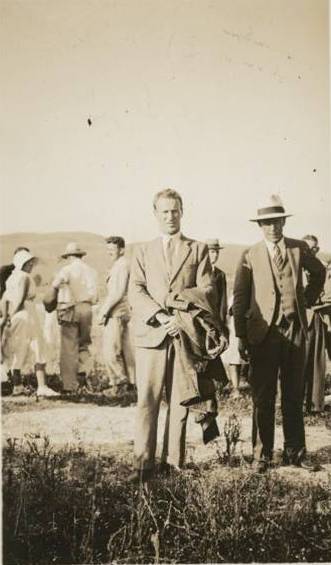
Portrait of brothers Sir Charles Kingsford Smith and Wilfrid Kingsford Smith, ca. 1930s nla.pic-vn3722853, courtesy National Library of Australia
During WWII all three of Wilfred’s sons served as pilots: see Smithy's three nephews carry on great tradition (left) Wing-Commander Rollo (left) served in the first Australian Lancaster squadron, Squadron-Leader John in New Guinea, and Flight-Lieutenant Peter in Europe before being a prisoner of war; photographed on Rollo's wedding day, November 23, 1940, the last occasion on which the boys were home together. All three had been trained in the ‘cow paddock’ that their uncle and father’s flying school at Mascot was situated in.
Rollo, who apparently wanted to be a doctor, continued a career in the R.A.A.F. until 1949: Wing-Cmdr. Kingsford Smith Resigns MELBOURNE, March 8 1949 Wing-Cmdr. Rollo Kingsford Smith, nephew of Sir Charles Kingsford Smith, who is in charge of the air and ground radio school at Ballarat, has announced that he will resign from the RAAF at the end of the month.
After the war Wilfred continued as principal of the College of Civil Aviation, helping ex-war pilots train for civilian flying: Need For Development (left). Clearly a driven man, who mixed driving his sons to achieve their best with his love of them, this flyer, instigator of connecting regional Australia with its larger cities, knew his forte was in building for others and for the future. We may all laud his younger brother but we should also applaud him for all the work he did in furthering aviation in Australia. That he was often mistaken for his brother, simply through a likeness, does not detract from all he was and achieved:
INTIMATE GLIMPSES OF "SMITHY'S" LIFE
Pathos, Humor, And Love Of Mother. EXCLUSIVE INTERVIEW WITH BROTHER; Intimate glimpses of the life of the world’s greatest airman, Sir Charles Kingsford Smith, in which the litre of adventure, pathos, humor and the love of a hardy little mother for her sons and her battle to prevent sentiment from interfering with their careers, were given to-day by Sir Charles's brother, Mr. Wilfrid Kingsford Smith, who is in Broken Hill in connection with the arranging of the Broken Hill-Sydney air service.
Many of the sidelights given in the exclusive interview with "The Barrier Miner" were related for the first time, as it was feared that if some were published elsewhere too soon after their occurrence feelings would be unnecessarily hurt.
IMPERSONATED BY BROTHER
The most startling' revelation and one that will set many people wondering was that Mr. Wilfrid Kingsford Smith has impersonated his brother at several public functions. Mr. Wilfrid's likeness to his famous brother made it unnecessary, to change anything but his name. "The clamoring of people to see Sir Charles and to shake him by the hand made it necessary for him to 'let up' occasionally," said his brother. "There was nothing else to be done' but forme to take his place. I well remember one occasion on which it had been announced that 'Smithy' and his mother would occupy a certain box at a theatre. At the last minute 'Smithy' took ill, and I agreed to take his place. Mother and I entered the box amid a storm of applause from an audience that had fought at the booking office to book seats.
"A light was focussed on us and I bowed and waved to those below. They could not see that I was slightly taller than the real 'Smithy.' It was certainly a 'Smithy' that greeted them, but ignorance was bliss."
On numerous occasions, Mr. Wilfrid Kingsford Smith has been cheered to the echo when alighting from planes by people mistaking him for his brother. "It suits 'Smithy,' said Mr. Wilfrid 'laughingly. "He feels under a great obligation to his elder brother for taking, the limelight away from him occasionally.”
TRIBUTE TO MOTHER
Tribute to the part played in the moulding of "Smithy's" career by his mother was paid by Sir Charles's brother, "It was only natural that when he first started these flights mother should worry for his safety and spend sleepless nights waiting for news of him. Yet she never displayed any sentiment.
''Her first words to him after each of his gambles with death were never of the type to hinder him in his career. She fought down the pleas which any mother would long to make in such circumstances and helped him on to further success."
An amusing but tragic little story was related by Mr. Wilfrid Kingsford Smith concerning "Smithy's" first conquest of the Pacific in 1928. "On his arrival at Mascot, there were more than a quarter of a million people waiting to greet him, and before the huge assemblage mother embraced and kissed Charles as soon as he alighted from the plane.
"Dozens of press photographers snapped the fond embrace and the photograph was published in all parts of the world with the catch line, 'God bless you, my son.'
"I told mother later that I could not imagine her letting sentiment get the better of her like that and she replied that she had said nothing of the sort. What she did say was, 'Charlie, you dirty little monkey, go and have a bath.’
That spirit was typical with. The hardy little mother. When her other son, Eric, joined the-navy during the war and featured in the sinking of the German cruiser Emden as a lieutenant on the Sydney, her sentiment was subdued and she sent her son off to further encounters with words of encouragement ringing in his ears.
SACRIFICES REWARDED
Her sacrifices have been rewarded. Eric retired from the navy through illness with the rank of commander, Sir Charles has won the distinction of being the world's greatest airman, and Wilfrid in one of the best known organisers of air routes in Australia. "We all owe our success to our mother and the encouragement she gave us despite the hazardous nature of our occupations," said Mr. Kingsford Smith. "She can. boast that she has 'two sons who hold world records in the air-Charles and myself. Charles is the world's best flier and I am the worst. - If that isn’t a record then Charles cannot claim, any records," added Mr, Kingsford Smith, who, despite his assertions to the contrary, is no mean hand with the joy-stick.
Discussing Sir Charles's - future, Mr. Kingsford Smith said that although his brother had promised his wife that he would give up dangerous record flying he would never do it. "He settles down for a few months and then his bones start to itch for fresh adventure and he is off again. It is in his blood, and he can never give it up.
GIVEN UP WORRYING
"I, for one, am content to let it go at that. I have given up worrying and just accept the inevitable. My brother, although daring, never takes a risk that can be avoided, and to use a legal phrase, only an act of God can. bring his end, in the air."
"Before he left he advised me to always select married pilots for my services because the- more married they were the more frightened they were, and frightened pilots were undoubtedly the safest. That outlook is typical of my brother in everything he does." concluded Mr. Kingsford Smith.
Mr. Kingsford Smith will be in Broken Hill until Monday completing arrangements for the new service to Sydney. He will then go to Wilcannia by car to finalise arrangements there.' INTIMATE GLIMPSES OF "SMITHY'S" LIFE. (1935, November 7). Barrier Miner (Broken Hill, NSW : 1888 - 1954), p. 5. Retrieved from http://nla.gov.au/nla.news-article46710495
 |
Mr Wilfrid Kingsford SmithResearch.pdf Size : 180.199 Kb Type : pdf |
|
Below: Running-up on the tarmac outside Kingsford Smith Air Service Hangar,
1920s, Sam Hood Home and Away – 844, Courtesy State Library of
NSW
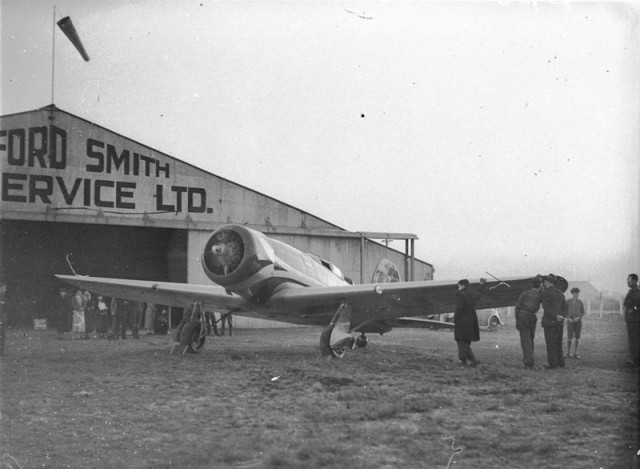
Further:
.jpg?timestamp=1336845145699) Smithy's
three nephews carry on great tradition - FAMILY ALBUM SNAPSHOT of
the late Sir Charles Kingsford Smith in 1916. Smithy, then 19 had been invalided
home, having collected the M.C. and foot injuries in a dogfight over France.
With him are his sister-in-law, Mrs. Wilfrid Kingsford Smith (left), three of
her children, Peter, John (back), Margaret and a family friend.
Smithy's
three nephews carry on great tradition - FAMILY ALBUM SNAPSHOT of
the late Sir Charles Kingsford Smith in 1916. Smithy, then 19 had been invalided
home, having collected the M.C. and foot injuries in a dogfight over France.
With him are his sister-in-law, Mrs. Wilfrid Kingsford Smith (left), three of
her children, Peter, John (back), Margaret and a family friend.
By VICKI
ANDERSON
Among the cheering quarter of a million spectators at Mascot
aerodrome when Charles Kingsford Smith stepped from the Southern Cross after his
epic trans-Pacific flight in June, 1928, were three small boys.
They were
Smithy's most ardent hero-worshippers, his nephews Rollo (9), Peter (11), and
John (14). THIS month, at the ripe old age of 25, Rollo, a wing commander,
winner of the D.F.C. and commanding officer of the most recently formed R.A.A.F.
bomber training unit in Britain, was awarded an immediate D.S.O.
Peter, after
distinguished service as a flight-lieutenant with the R.A.A.F. in England, was
shot down over Europe last year, and is now a prisoner of war in
Germany.
John, an outstanding pilot in civil aviation before the war, is now
squadron-leader of an operational unit in the North. It is to be hoped that the
scene of the three boys at the aerodrome will be included in the film now being
made in Australia of the life of the late Air-Commodore Sir Charles Kingsford
Smith. They are the sons of Mr. and Mrs. Wilfrid Kingsford Smith, of Neutral
Bay.
A brother of "Smithy," Mr. Wilfrid Kingsford Smith figured prominently
in pre-war civil aviation, originating many inter-city airmail services,
including that from Sydney to Broken Hill. Youngest of these flying nephews,
Wing-Commander Rollo Kingsford Smith, was until recently the youngest
wing-commander in Allied operational command in England. That the influence of
his uncle is ever present is revealed in his only comment on his decorations: "I
guess the old boy would approve."
In an interview with Rollo's
pretty23-year-old wife at Mosman, I learned that this brilliant young
wing-commander finds his greatest excitement not in flying, but in listening to
a stranger in some obscure part of England recall the exploits of his
uncle.
"Nothing can compare with the kick I get out of it," he wrote his
wife. "It's good to know the old boy is so well remembered by everyone I
meet-that is everyone except the editors of that darned newspaper."
"That
darned newspaper" was an English daily, which, after writing at length on
Rollo's exploits, evidently got its Kingsford Smiths slightly mixed, and
concluded by crediting Rollo with flying the Pacific in1928. "Darling," wrote
Rollo to his wife just after the story was published, 'I’ve kept something from
you. I flew the Pacific when I was nine.''
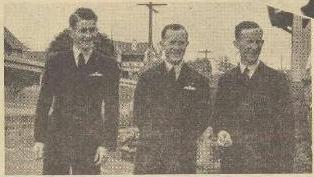
Left: THE THREE FLYING NEPHEWS of the late Air-Commodore Sir Charles Kingsford Smith-Wing-Commander Rollo (left), Squadron-Leader John, and Flight-Lieutenant Peter photographed on Rollo's wedding day, November 23, 1940. It was the last occasion on which the boys were home together. In his letters to his wife, always nine pages at the least, Smithy's youngest nephew is a master of understatement in references to any of his operations, now totalling 35.
"Went to do battle with the wicked Hun last night," or "We had quite a
party, and, oh, yes, the plane caught on fire, but I kept my fingers
crossed."
This from a young airman who is flying sometimes four operations a
week, and whose citation accompanying his D.F.C. read:
"This officer is a
gallant squadron leader whose contempt for danger and outstanding ability have
been well reflected in the operational efficiency of *is squadron."
Shades of
1916 when 19-year-oldCharles Kingsford Smith, flying a suicide crate, won the
M.C. for "exceptional bravery when engaged with enemy aircraft over
France."
For two weeks before the European invasion Wing-Commander Kings-ford
Smith's squadron was working twelve hours on with only four hours off.
The
highlight of each raid was the party on the return trip home. " Just before
sighting the English coast we'd put on the automatic pilot and settle down to a
spread of chocolate, orange juice, and dried fruit," Rollo wrote his wife.
As
a boy, remembering his uncle's advice that to be a great flier you had to be a
great mathematician. Rollo concentrated on maths, at Sydney High School,
graduating with Maths honors in the Leaving. As a cadet at Point Cook he won his
wings early in 1939. Studying navigation at Richmond, he was one of the first
nine fliers to obtain a first-class navigator's certificate (certificate No. 1
is held by the famous Captain P. G. (Bill) Taylor).
Rollo arrived in England
in May, 1943, and later led the first Australian Lancaster squadron on a Berlin
raid. News of his immediate award of the D.F.C. was given him in the officers'
mess by the Prime Minister Mr. Curtin during his visit to England in
April.
Rollo's wife, who was formerly Miss Grace Prior, of Mosman, still
regards her tenth birthday as one of the most important days of her life, for it
was the day Charles Kingsford Smith was married. "I was thrilled as could be,
little realising that one day I would be-come a member of the family," she said.
They have a two-year-old daughter, Sue.
Rollo's brother Peter, who was in the
Militia, joined the Air Force in 1940, and later left for overseas. During a
hazardous convoy crossing from Canada to England, when the ship in which he was
travelling in was -attacked by planes, he took charge of the ship's
anti-aircraft guns. Reported missing on a raid over Europe in February last
year, he was not captured until four months later. The story of how he was kept
in hiding by Allied sympathisers during those months is probably as dramatic as
any to be told after the war.
First news Mrs. Wilfrid Kingsford Smith
received of her son after he had been reported missing was a cable from an
Englishwoman: Mrs. H. Nicholls, of Moss Lane, Pinner, who has proved a splendid
friend to hundreds of young Australian airmen in England. "The cable stating
that Peter was safe was a tremendous relief to us after all those anxious months
of not knowing whether he was dead or alive," Mrs. Wilfrid Kingsford Smith said.
"Mrs. Nicholls deserves a medal for the wonderful job she is doing. Since Rollo
first spent a leave at her home a year ago, she has thrown open her home to more
than 500 lonely young Australian airmen. "The boys and their families back
home, with whom she keeps in touch, are very grateful to her."
The third of
these flying brothers, John, now a squadron-leader of an operational unit in the
North, early in 1937 established a high-altitude record for light
aircraft.
Permission is being sought for John to be released from the Air
Force to fly aircraft for the film of Kingsford Smith's life. This film, which
will be the most expensive ever made in Australia, is being backed by Columbia
Pictures and produced by the managing, director of Columbia Pictures Pty. Ltd.
in Australia (Mr. N. P. Perry).
Director Mr. Ken G. Hall says that he has
discovered eight prospects for the part of Smithy, and more than 20 applicants
who bear remark-able resemblances to the great air man. Smithy's former wireless
operator, John Stannage, will appear in the film. Liaison officer
SQUADRON-LEADER Bill Chaseling, another old friend of the airman's, will act as
liaison officer between the R.A.A.F. and Cinesound.
Smithy's wife, Mary (now
Mrs. Alan Tully), who will also be represented in the film, is now living at
Atlanta, Georgia, U.S.A., with her son Charles, and a daughter by her second
marriage, Belinda. A recent letter to the family said that "Charles II" had just
gone into his first pair of long pants.
Although scenario writers are
juggling now with enough material for three pictures of Smithy's colorful life,
hundreds of friends and acquaintances of Smithy continue to flood the studio
with little-known anecdotes and sidelights on his career.
His family, all of
whom will be represented in the film, are hoping that this particular favorite
one will be included in the scenario: The central figures are Charles and his
mother, who died three weeks after all hope had been abandoned for her son, lost
off Burma while attempting a record flight from England to Australia in
1935.
The scene was Mascot aerodrome, June, 1928, with the cheering thousands
and Charles (or "Chilla," as his adored and adoring "Nan" always called him)
rushing to greet her after his harrowing nine-day flight from San Francisco.
Taking one look at the nation's idol, with his grease-stained face and
flying-suit, she gasped: "Chilla, you dirty little monkey. Go straight home and
have a bath." Smithy's three nephews carry on great tradition. (1944, September
2). The Australian Women's Weekly (1933 - 1982), p. 16. Retrieved from http://nla.gov.au/nla.news-article47217119
NEED FOR DEVELOPMENT Mr. KINGSFORD-SMITH'S IMPRESSIONS.
Cairns, with
its surrounding districts, should be the greatest 'tourist resort in Australia
and the head-quarters of one of the world's finest scenic centres. This was the
opinion of the city’s potentialities, expressed yesterday by Mr. Wilfrid
Kingsford-Smith, an elder brother of the .late Sir Charles; who has almost
completed a fortnight's visit to the district. Mr. Kingsford-Smith spent mach,
of his boyhood In Cairns. He suggested the opening of further exploitation of
the coral, islands, the establishment of tourist resorts in the inlets of
Trinity Bay, further advertisement of "our marvellous lakes” as he termed
them-Barrine and Eacham. Only the Barron Falls were publicised in the south, he
added. Mr. Kingsford-smith added that increased industrialisation should be
facilitated by the comparatively 'cheap electrical power. He considered that air
travel had played a noteworthy part in the-district's development to
date.
CITY BANKS' HISTORY
A little of the city's earliest : banking
history was revealed by Mr. Kingsford smith, whose, family background is closely
associated with Cairns of the-early days.
His father, Mr. W. Smith, opened
the Bank of New South Wales in a tent in Cairns in the late 1870's. Soon after
that he married , the daughter of the late Mr. R. Kingsford, and the family
assumed the name of Kingsford-smith.
Next, Kingsford-smith, senior, joined
the Queensland National Bank-it was customary for men in those days to transfer
from one bank to another as opportunities offered. The bank, even then, was a
two-storied wooden building, on its present site. At that period the two eldest
of the seven Kingsford Smith's were born.
Mr. Kingsford-Smith's third and final venture in Cairns was in 1892, when he joined the Bank of North Queensland as its manager. That bank became the National Bank in Cairns. The family home, "Invicta," was for many years a landmark in Cairns, it occupied the vacant allotment on the Esplanade, where the Canberra Hotel is to be built "Fairview," the Kings' ford's old home, was later purchased by the Munro estate and by reason of its isolated position, was used for secret works during the war by the “Z” Experimental Section.
The "Kingsford-smith family left Cairns in 1896, a
year before the birth of Sir Charles. "If he had lived he would be 50 next
year," ' said his brother.
Mr. D. Headrick and the Town Clerk (Mr. A. E.
Wilkinson) were schoolmates of the Kingsford-Smiths, as were also Mr. C. Cannon,
Mrs. Les. Walker, of Hambledon and Miss Prewitt. His visit to Cairns after many
years in metropolitan centres bas made a very happy impression on Mr
Kingsford-smith. He commented on the absence of drunkenness in the city a factor
for which he 'declared later closing- hours was responsible. It afforded a
pleasing .contrast to the position in Sydney and Melbourne. Again, in contrast
to conditions in the metropolis, he was impressed by the orderly conduct of
young people at the city's seaside -resorts. Service afforded by every
section-of the community also, evoked warm praise. He stated that he, his wife
and Mrs Tate, of Sydney, who have been in Cairns almost a fortnight "had
received excellent and cheerful service from everyone-hotel and shop assistants,
car drivers, etc.
FIRST CRASH
Mr. Kingsford-Smith humorously
referred to Sir Charles' first ''crash'' as a boy of eight; " He extended, the
ribs of an umbrella by adding oiled silk made a propeller which was fastened
behind his back with a ratchet and a handle at his side. On the trial day he
jumped off an out-house, sailed about12 feet, then the umbrella collapsed and he
landed, dislocating a collar-bone.”
All three sons of Mr and Mrs. Wilfrid
Kingsford-Smith served with the RAAF, during the war,-"bringing home a gong or
two," as their father put it. He is Head of the Kingsford Smith
engineering company at Brisbane, Sydney and Melbourne, but his greatest interest
is in his position as head of the College of Civil Aviation, where air
navigation is taught to former R.A.A-F. personnel who wish to enter civil
airlines. There radar will, be taught for the first time in the world under
civilian conditions, and instruction is to be given in the near future in jet
propulsion. Mr. and Mrs. Kingsford-smith and Mrs. Tate, who are
staying at the Strand Hotel, will leave by plane to-day to return to the
south.' NORTH'S BEAUTIES. (1946, July 20). Cairns Post (Qld. : 1909 - 1954), p.
7. Retrieved from http://nla.gov.au/nla.news-article42503285
Extensive Aviators website: http://www.ctie.monash.edu.au/hargrave/pioneers.html
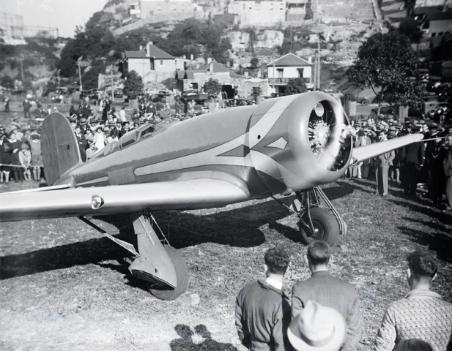
Kingsford-Smith prepares to take-off in Anzac (name papered over on the side and changed to Lady Southern Cross), Anderson Park, Neutral Bay. Date of Work; 17 Jul 1934, Call Number Home and Away – 4304, "Taken for the "Argus", "Star" and "Australasian", published in Melbourne." (Ted Hood, 13/1/90) Smithy's Lockheed Altair, "Lady Southern Cross", Courtesy State Library of NSW
Charles Kingsford-Smith with his Mother and Father, 1928 / photographer unknown, Digital Order No. a4362093, courtesy State Library of NSW
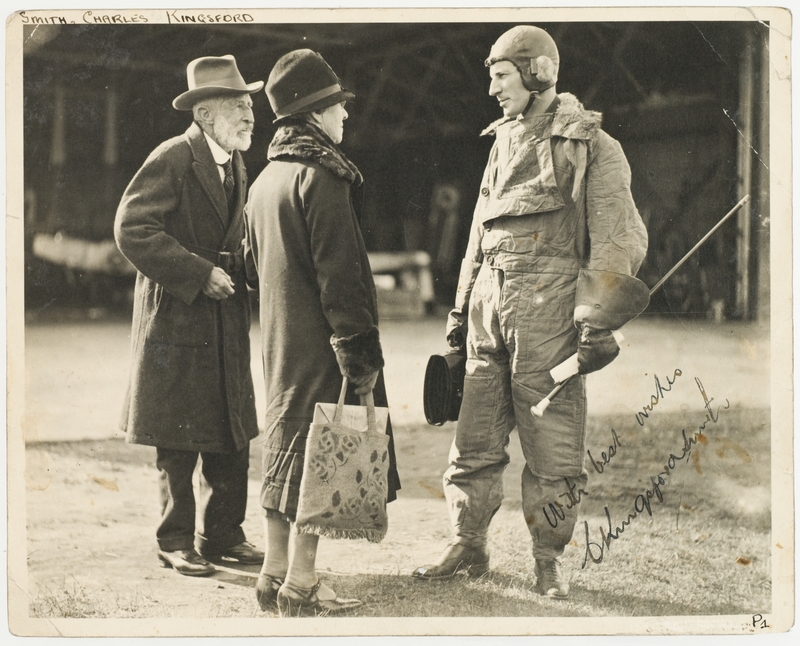

.jpg.opt916x687o0,0s916x687.jpg)
Above: House at Taylors Point for Mr W. Kingsford-Smith, 1939, No. a1422024 and No. a1422026 - Album: Volume 6: Residences, including those for Max Dupain and Douglas Annand - courtesy State Library of NSW.